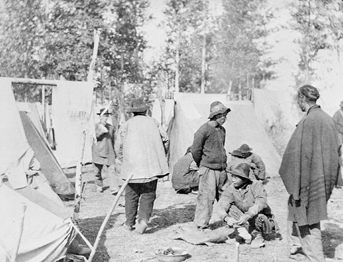
Railroad labourers at a Chinese work camp, near Kelowna, British Columbia, 1886. Courtesy of Library and Archives Canada / C–016715
Construction of the Canadian Pacific Railroad (1881–1885)
The abundance and relative low cost of Chinese labour made Chinese workers crucial to railroad construction in western Canada. Fifteen thousand Chinese men performed the bulk of the work on the most dangerous part of the CPR in British Columbia. Harsh living conditions and hazardous work led to high injury rates and 600 fatalities among the Chinese labourers. When the railroad was completed in 1885, Chinese labourers entered other industries like fishing and agriculture, opened their own restaurants and laundries, or worked as domestic servants. Although the majority of the Chinese population remained in British Columbia, some moved east, typically settling in larger cities.
Listen to Judi Michelle Young describe her father's jobs on the CPR at the end of the 19th century. click for summary


